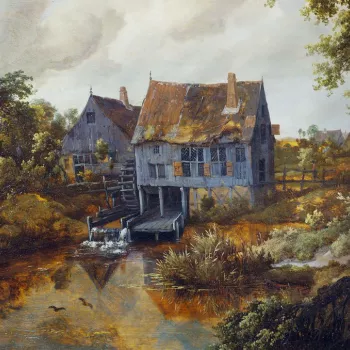A Watermill beside a Woody Lane Signed and dated 1665 or 1668
Oil on panel | 52.3 x 68.2 cm (support, canvas/panel/stretcher external) | RCIN 404577
-
Hobbema was born, worked and died in Amsterdam. The name ‘Hobbema’ was his own invention; his father was called Lubbert Meyndert. On 8 July 1660 Hobbema testified before an Amsterdam notary that he had spent several years ‘serving and studying’ with Jacob van Ruisdael. He married in 1668 and became a wine gauger for the Amsterdam authorities, after which his artistic output waned.
In this engaging landscape Hobbema transforms a mundane view of everyday life into a charming scene of fairytale innocence. The winding path on the right curves around away from the watermill, teasing attention away from the main motif. Watermills appear in about 35 paintings by Hobbema, the majority of which are variations on drawings made from actual buildings. Despite this repetition of the motif, each depiction of a mill by Hobbema differs in the angle that is presented as well as the mood of the scene. This dilapidated example seems to be based on one he had seen in Deventer and recorded in drawings in the Teylers Museum Haarlem and the Musée du Petit Palais, Paris (Dutuit collection).
The predominant use of an orange and brown palette is typical of the artist and also lends the painting an appealing brightness. Figures inhabit this idyllic space; a man walks down the path, a woman and child sit to the side of it, and a man – possibly the mill owner – crosses a bridge to enter the mill. These distinct characters blend seamlessly with their surroundings and, together with the birds which swoop close to the water, harmoniously interact with nature. From the first mentions of landscape painting in the Renaissance it was thought to be the source of a peculiarly simple, restful pleasure. It was for this reason that it was associated with music: Paulus Bril’s Self-Portrait of c.1590 (Rhode Island School of Design) shows the artist playing a lute while a delightful wooded landscape is stretched on the easel in front of him. The fictional world that Hobbema creates similarly seduces the viewer with the imaginary sounds of rustling leaves and splashing water and with images of contentment: houses nestling amongst trees; calm clouds reflected in the surface of the water. Like Jacob van Ruisdael and Salomon van Ruysdael, Hobbema presents a perfect vision of his homeland, but with his distinctive, somewhat eccentric, flavour.
Signed and dated lower right corner: 'M. Hobbema /f. 166[5 or 8]'Provenance
Purchased by George IV from Sir Thomas Baring as part of a group of 86 Dutch and Flemish paintings, most of which were collected by Sir Thomas’s father, Sir Francis Baring; they arrived at Carlton House on 6 May 1814; recorded in the Anti Room, Ground Floor, at Carlton House in 1819 (no 142); in the Picture Gallery at Buckingham Palace in 1841 (no 151)
-
Medium and techniques
Oil on panel
Measurements
52.3 x 68.2 cm (support, canvas/panel/stretcher external)
67.2 x 82.7 x 5.0 cm (frame, external)
Category
Object type(s)
Other number(s)










